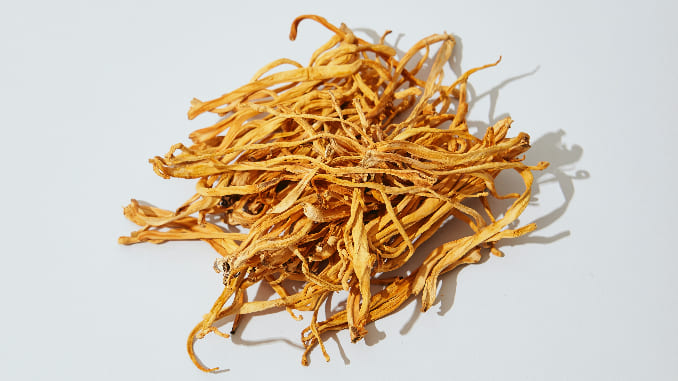I first heard about them when I was in the depths of my YouTube-induced vegan era. Functional mushrooms were just beginning to come onto the scene (or were just starting to be pumped into my algorithm), and I saw seemingly countless sponsored posts for a company called Four Sigmatic, which sells a variety of powdered functional mushroom products. There were products made from mushrooms I had heard about before, like lion’s mane and turkey tail. But that was the first time I’d ever heard about cordyceps.
Several years later, and cordyceps are popping up everywhere. Odyssey Elixir makes sparkling, caffeine-spiked beverages that feature cordyceps as a main ingredient and supposedly promote energy and focus. FreshCap provides customers with a variety of functional mushroom products and offers cordyceps capsules, extracts and even gummies. And these days, you can even buy cordyceps from your local Wal-Mart’s supplement section.
But what exactly are they? As it turns out, they’re running a nature-sanctioned horror show that could easily put Ari Aster out of a job if A24 decided to pick it up. Cordyceps are a type of fungus, the spores of which infect different species of insects. When the insects become infected, their minds are essentially hijacked by the fungus; they suddenly move from their protected shelters and find a spot where the fungus can grow adequately.
Then, horrifyingly, the fungus begins to grow, soon sprouting out of the body of the afflicted insect. The insect, now dead, becomes fodder for the parasitic fungus. It slowly grows until it’s once again ready to reproduce. At that point, the spores release from the tip of the fungus, continuing the horrific lifecycle, hopefully (for the cordyceps) infecting other insects in the process. Although humans generally eat the type of cordyceps that spring from the body of caterpillars, there are literally thousands of varieties of cordyceps, each which is designed to infect specific species of insects.
Despite its nightmarish status as a killer in the world of insects, cordyceps have been celebrated by humans across the globe. Before they got their status as a Western superfood, they were used in traditional Chinese and Tibetan medicine. One study found that cordyceps were used by practitioners to treat 21 separate ailments, including kidney disease and impotence. There’s a reason it’s called “Himalayan Viagra” (as most of it comes from Tibet), after all.
According to Healthline, cordyceps offer a wide variety of health benefits. Not only have they been shown to improve exercise performance and contain anti-aging properties, but they can also potentially aid heart health, help people with Type 2 Diabetes and reduce the risk of tumors. That being said, many of the studies that have shown that cordyceps can have these effects are considered low-quality; we have yet to discover how cordyceps can truly function as reliable sources of medication.
Despite the potential benefits, there are some people who will want to avoid cordyceps. WebMD tells us that some side effects can pop up for certain individuals: Nausea and dry mouth can occur after ingestion. If you suffer from these symptoms after taking cordyceps, you may want to think twice about using them on a regular basis. There haven’t been enough studies to determine if cordyceps are safe for people with cancer, diabetes and other medical conditions. Kids and pregnant people should also avoid them to be safe. Plus, you’ll want to ask your doctor if cordyceps are appropriate for you before you take them; like any supplement, they can cause problems for people who are on certain medications, like blood thinners.
Admittedly, after learning about what cordyceps were, I was a little hesitant to try them. Google them in their un-powdered form, and you’ll find that they look distinctively insect-like, which, combined with my not-totally-resolved fear of fungus, makes them feel slightly intimidating. But perhaps food marketers know that, as the cordyceps products I’ve tried have all incorporated the ingredient in a subtle fashion. The powder is easy to pour into your coffee in the morning; it barely has a taste. The pre-made drink I tried that contained cordyceps displayed no trace of a mushroom-like flavor of any sort.
It seems like these days, companies producing anything involving mushrooms will try to adopt the tone and aesthetic associated with psilocybin, but for me, the groovy graphic design and purported mild cognitive effects aren’t a great selling point compared to, you know, actual drugs. Maybe leaning into the absolutely bizarre world of parasitic fungus would be a better strategy.
Samantha Maxwell is a food writer and editor based in Boston. Follow her on Twitter at @samseating.
